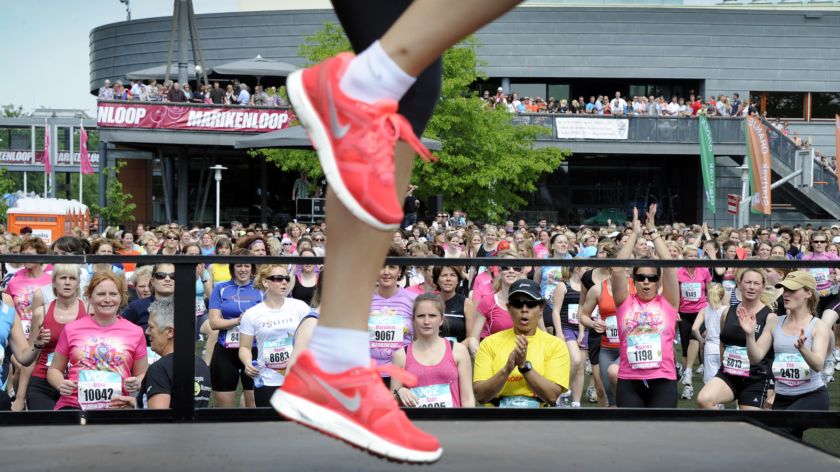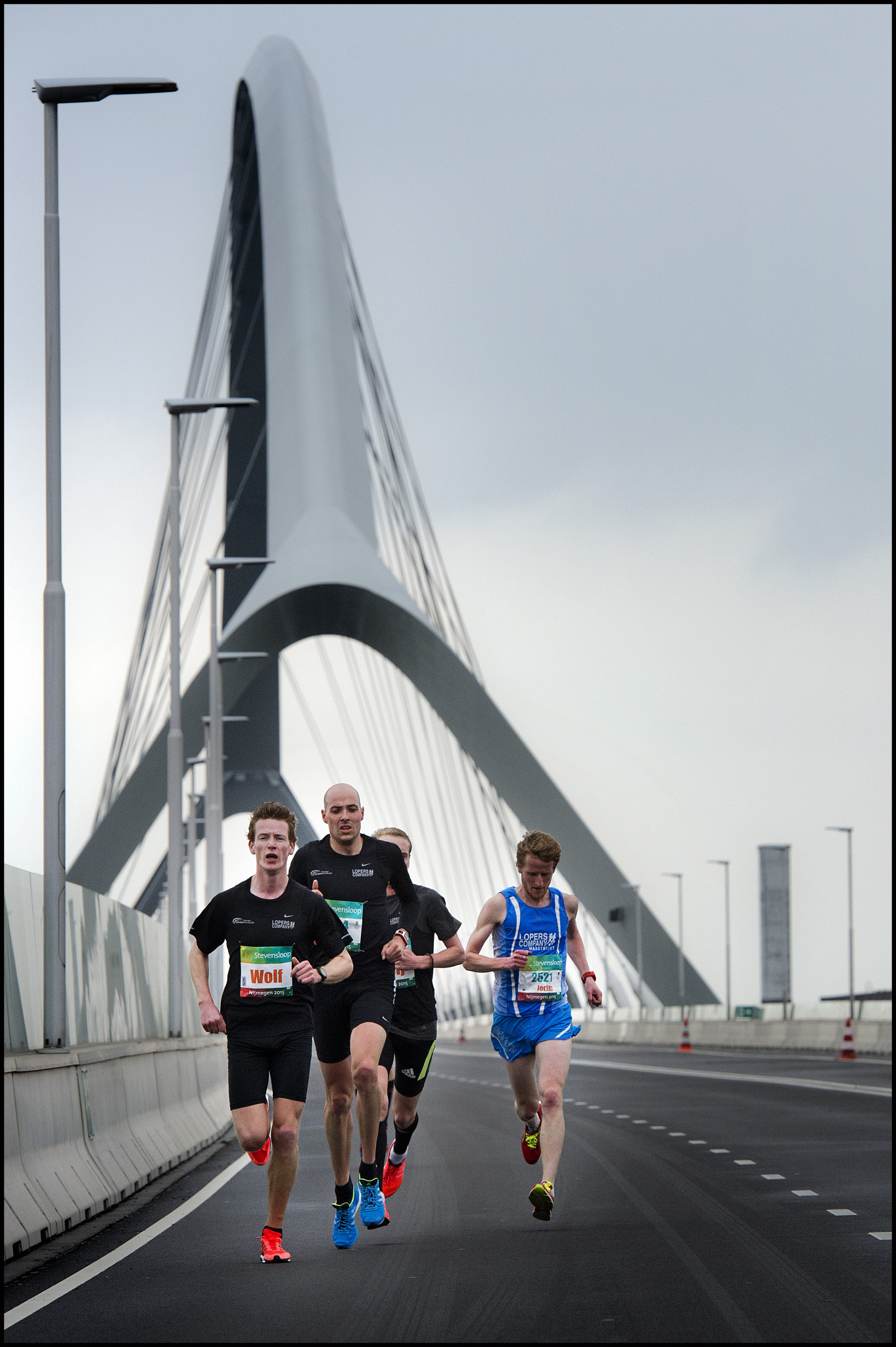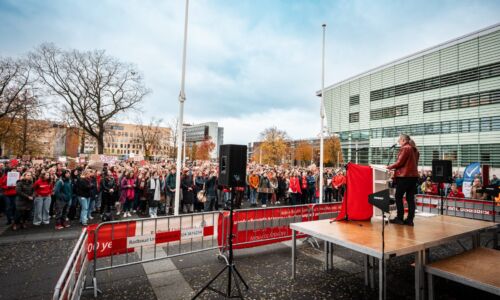Students make Nijmegen into running city
-
 The start of the Marikenloop at the Radboud Sports Centre. Photo: Bert Beelen
The start of the Marikenloop at the Radboud Sports Centre. Photo: Bert Beelen
With the Batavierenrace and the Seven Hills Run Nijmegen is home to two world-class running events. It has the students to thank for its reputation as a running city.
Nijmegen’s claim to the title of ‘running city’ is the result of a joke getting out of hand. Or rather two jokes getting out of hand. The first one dates from 1973, and the birth of the Batavierenrace. Jacques Ypma, then Director of the Radboud Sports Centre, had heard of a Swedish student relay race and wished to organise something similar in Nijmegen. Among other people, he involved physics student Stan Gielen, then President of the Netherlands Organisation for Scientific Research. ‘At the time, the University was suffering from an inferiority complex with respect to the Randstad region. There was a strong feeling that we had to come up with something exceptional,’ says Gielen. And the exceptional materialised: in April 1973 four hundred students stood at the starting line of a running race between Nijmegen and Rotterdam, a relay race with 25 stages. The Batavierenrace was born. ‘We just wanted to organise a fun running event.’
The second joke was an idea to brighten up the fifth anniversary of the Students Athletics Club ’t Haasje in 1984. In the members’ assembly, people were asked to come up with ideas. Henk Stevens raised his hand. He had spent most of the 1970s drinking and smoking his way through student parties, but had by then been actively running at ’t Haasje for some years, ‘otherwise, I felt, I would not live to see my fortieth birthday’. Stevens’ plan: a race between Nijmegen and Groesbeek, immediately baptized the Zevenheuvelenloop (Seven Hills Run), which in its first edition during the lustrum celebration brought five hundred runners to the finish line after a twelve-kilometre run. A few years later the distance was increased to the now classical fifteen kilometres. Why fifteen kilometres? ‘Because it was my favourite running distance,’ says Stevens.
The rest is history. In April this year, the 43rd edition of the Batavierenrace was run by 8,341 students from the Netherlands and abroad, while the latest Seven Hills Run was completed by no less than 25,552 runners. Nijmegen has gained a reputation as a running city (see box), the more so now that the Marikenloop (since 2003) and the Stevensloop (2014) have also been added to our calendar. Did the founders of these races ever dream that the city would welcome more than 50,000 runners a year? That we would make it into the Guinness Book of Records with the world’s largest relay race? That we would achieve national fame with ‘the most beautiful route in the Netherlands’? We decided to go in search of the roots of the Nijmegen running craze.
Chip
Already during the first edition of the Batavierenrace, Stan Gielen thought that the race might be long-lived. ‘The atmosphere was fantastic, it felt like the Four-Day Marches. And we immediately had a very diverse set of teams.’ When he once again attended the start of the race a few years ago, Gielen saw the durability of his 1973 recipe confirmed. ‘The script we devised at the time has hardly been modified since.’ With the exception of the route: after one year, the finish was moved from Rotterdam to the University of Twente.

Henk Stevens also believed from the start in the success of ‘his’ Seven Hills Run. He recounts the tiny advertisement used in 1984 to attract runners to Nijmegen. ‘The response was overwhelming: not only from our region, but from the entire country, runners flocked to Nijmegen. People from Den Helder wanted to try something different than racing in the polder.’ Word of mouth advertising about the truly beautiful route did its work, Stevens concludes with satisfaction. He believes that the fact that the race was organised ‘by runners for runners’ has also been one of the pillars of its success. ‘We welcomed all runners, not only top athletes. We were the first to have this attitude.” In other races, Stevens remembers, runners were issued a bib number and were required to keep track of their time themselves. But not in Nijmegen: everyone was given a precise finishing time, after a few years refined with the famous shoelace chip for automatic time registration. Stevens is still incredibly proud of this invention: a gadget devised by his own organisation has become popular throughout the world.
‘A run organised by runners, like the Seven Hills Run or the half marathon in Egmond, feels different. Normally,Tourist Offices and events agencies organise races, and usually they are organised the same way as cheese markets: it’s all about money and publicity.’
Mafia
The success of the one race infected the other. This is the conclusion of Daan van den Berg, who entered the running scene in 2010 as a Public Administration student: first in the Batavierenrace (as runner, organiser and president), then in the Seven Hills Run. ‘The Seven Hills Run is even more professional. In our field we call this kind of organisation an ‘organisation university’.’ Van den Berg was involved in organising the very first Stevensloop in 2015 – a spinoff of the Seven Hills Run – where he was responsible among other things for creating the route. “It was a resounding success resulting in us having to close registration even earlier this year.”
Thus the virus can spread further, fuelled by an increasingly strong ‘running mafia’. This phrase comes from Ton van Lieshout, self-appointed member of the mafia in question as treasurer of the Seven Hills Run from the time of its foundation and President of the organising foundation for years now. According to him, the race’s roots in the student world contribute a bit of eccentric bravura to the running world: ’t Haasje was known as the odd man out among athletics clubs, while the Seven Hills Run was touted as a counterweight to the Four-Day Marches, “as part of the long-lived Nijmegen countermovement against the established order.”
This contrariness went hand in hand with a great deal of professionalism, says Henk Stevens, 25 editions later – and until 2009 – President of the event. ‘Every year we would come up with something new. We were committed to the environment and so we made a deal with the NS.’ This resulted in train discount arrangement and a higher entrance fee for motorists. Stevens still remembers with a smile the great headline in De Telegraaf: ‘Nijmegen excludes cars’. ‘We never sat still, and so the race kept getting better.’ And more sustainable. And bigger.
[kader-xl]BEATING HEART
Nijmegen would never have become the running city it is today without its students. Or without the University Sports Centre for that matter. Since the early days of the Seven Hills Run, the Centre has acted as the running event’s base. The organisation was located in the Gymnasion and in the first years the start line was on campus. Nowadays the runners depart from the Groesbeekseweg. The event’s younger sister, the Marikenloop, introduced in 2003, still starts at the University Sports Centre. The Centre is, at its own request, the beating heart of this running event. Athletes such as Susan Kuijken, winner of the 2013 5 kilometre Marikenloop, also come to the sports centre to train.
Running events could not be organised without volunteers. The latter are usually members of the Nijmegen student sports associations. The Batavierenrace has its office at the Sports Centre in De Ondergang, and it has by now become a tradition for Batavierenrace committee members to later play a role in organising one of the city’s other running events.[/kader-xl]
Intelligence
The four ‘running Mafiosi’ do not find it surprising that the virus should spread in student cities. Henk Stevens mentions the Heart of Brabant Run and the Veluweloop, two other successes with roots in student cities, Tilburg and Wageningen respectively. Runners are basically intelligent people, concludes Stevens: an individual sport is easy to fit into the schedule of students and working people, and a certain degree of intelligence is required to successfully complete long distances. He explains that runners, as opposed to team athletes or cyclists, always have to rely on their own insights, even when they make it to the top: they don’t have a team supporting them or a coach on the side-line. ‘You have to learn to really listen to your body and understand how it works, you have to know what to do, and especially what not to do, to train well. An individual sport requires intelligence,’ says Stevens. ‘Without our students and sports centre, Nijmegen could never have become the running city it is today.’
In addition to intelligence Nijmegen has another, unique, trump card: its surroundings. Stan Gielen argues that Nijmegen was one of the first cities in the 1970s to promote grassroots sport. ‘The idea that it might be fun to go for a run in the woods next to your club house.’ But for that you have to have woods. Gielen points to the athletics clubs in Rotterdam and Amsterdam, condemned, with their clubhouses surrounded by buildings, to running laps around the track. And then there is Nijmegen: the sports centre, founded in 1966, is located steps away from Heumensoord. Until today every runner who gets to know this area is pleasantly surprised by the beautiful surroundings. ‘It strengthens the feeling that you engage in sports to live a good healthy life, something that Nijmegen and its surroundings offer plenty of.’
Henk Stevens now operates Stadsoase, an accommodation on the edge of the woods in Nijmegen-Oost where he even welcomes top athletes from Australia. ‘They come to Nijmegen to train. These people have been all over the world and they say that this is the most beautiful place to run.’ Daan van den Berg believes that the surroundings inspire people to go for a run. ‘An incredible ninety per cent of the participants in the Stevensloop are locals. For a relatively small city we are home to a lot of runners.’ Ton van Lieshout also mentions the surroundings being an important trump card. ‘It is mostly thanks to its beautiful surroundings that Nijmegen has grown into a real running city.’
This is a story by Paul van den Broek and Gijs Swennen, published in Vox #2



